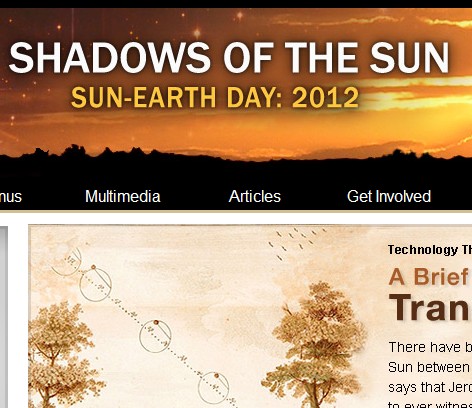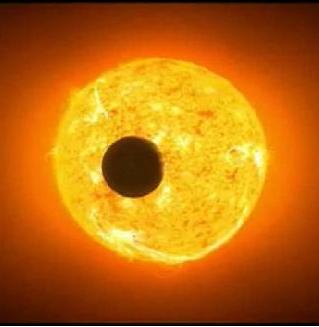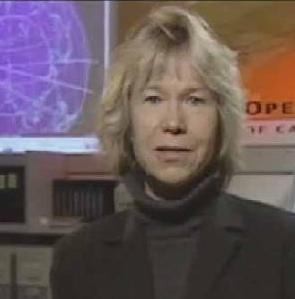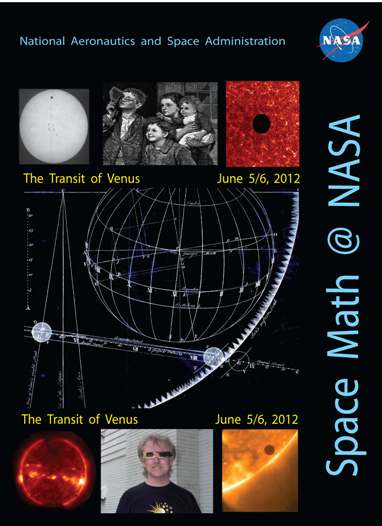Space Math @ NASA - Transit of Venus 2012 Resources
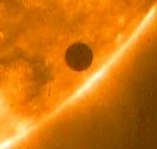 Between June 5 and June 6, 2012 the planet Venus will pass across the face of the sun as viewed from Earth. The last time this happened was June 8, 2004 and before then, the transits occurred in the years 1882 and 1874. Millions of people viewed this re-occurring event world-wide. Astronomers also studied this event in order to figure out the distance of the Earth from the sun.
This resource page puts together some of the information related to the transit that have interesting mathematical aspects to them, especially in geometry. Students will learn about parallax, chords of circles, and constructing scale models of the solar system.
Between June 5 and June 6, 2012 the planet Venus will pass across the face of the sun as viewed from Earth. The last time this happened was June 8, 2004 and before then, the transits occurred in the years 1882 and 1874. Millions of people viewed this re-occurring event world-wide. Astronomers also studied this event in order to figure out the distance of the Earth from the sun.
This resource page puts together some of the information related to the transit that have interesting mathematical aspects to them, especially in geometry. Students will learn about parallax, chords of circles, and constructing scale models of the solar system.
 Transit Mathematics -- This problem book allows students to explore astronomical eclipses, transits and occultations to learn about their unique geometry, and how modern observations by NASA's Kepler satellite will use simple transit math to discover planets orbiting distant stars. A series of Appendices reveal the imagery and history through news paper articles of the Transits of Venus observed during the 1700 and 1800s.
Contains 44 math problems, ... pages, .... illustrations.... 14.6 Mby PDF file.
Transit Mathematics -- This problem book allows students to explore astronomical eclipses, transits and occultations to learn about their unique geometry, and how modern observations by NASA's Kepler satellite will use simple transit math to discover planets orbiting distant stars. A series of Appendices reveal the imagery and history through news paper articles of the Transits of Venus observed during the 1700 and 1800s.
Contains 44 math problems, ... pages, .... illustrations.... 14.6 Mby PDF file.
- Download document with answer keys --- From Here.
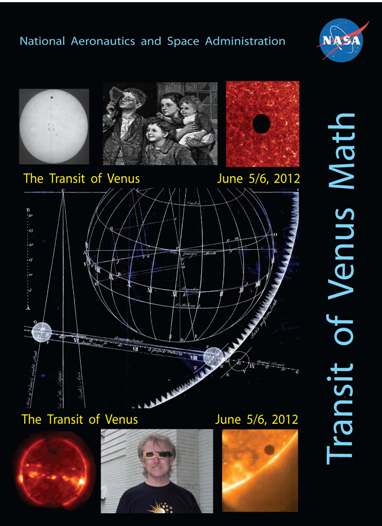





Transit of Venus Mathematics
-- This problem book covers 17 specific mathematics problems that are common to studying the transit of venus more critically. These include:geometry of chords and triangles,
working with angular measure,
unit conversion exercises,
parallax and
angular size,
angular speed,
time zone conversions,
working with proportions,
and a few problems involving trig!
Grade 7 - 9---The majority of the problems may be undertaken by grade 7-9 students. This resource is also helpful for the amateur astronomer wishing to gain a better understanding of parallax, transit geometry and how the Astronomical Unit can be deduced. The book contains 16 math problems, 37 pages, 20 illustrations 2.5 Mby PDF file.
- Download document with answer keys --- From Here
Featured Math Problems
Over the years, SpaceMath@NASA has developed many math problems that cover the topics spanned by the transit of Venus including angular size, proportion, areas of circles, and triangulation.
Kepler Exoplanet Transit Explorer
Problem 444: Predicting the Transits of the Stars Kepler-16A and 16B from Tatooine - II
Students determine how often the two stars Kepler 16 A and B will line up with Tatooine on
the same day of the year. [Grade: 6-8 | Topics: comparing two sequences of numbers; patterns, Least Common Multiple]
(PDF)
Problem 443: Predicting the Transits of the Stars Kepler-16A and 16B from Tatooine - I
Students explore the orbit speeds of Tatooine and Kepler-16B and predict how often the two stars line up with the planet
to create an 'eclipse'. [Grade: 6-9 | Topics: angle measure; angular speed]
(PDF)
Problem 441: Exploring the new planet Kepler 16b called 'Tatooine'
Using the tangent function, students estimate the angular diameter and separation of the two stars in the Kepler 16 binary system as
viewed from the planet's surface...if it had one!! [Grade: 8-10 | Topics: angle measure; tangent]
(PDF)
Problem 416: Kepler probes the interior of red giant stars Students use the properties of circular arcs to explore sound waves inside stars. [Grade: 8-10 | Topics: geometry of circles and arcs; distance=speed x time] (PDF)
Problem 403: The Goldilocks Planets - Not too hot or cold Students use a table of the planets discovered by the Kepler satellite, and estimate the number of planets in our Milky Way galaxy that are about the same size as Earth and located in their Habitable Zones. They estimate the average temperature of the planets, and study their tabulated properties using histograms. [Grade: 6-8 | Topics: Averaging; histogramming] (PDF)
Problem 402: Kepler- Earth-like planets by the score! II Students use recent Kepler satellite data summarized in tabular form to estimate the number of planets in the Milky Way galaxy that are about the same size as our Earth, and located in their Habitable Zones were liquid water may exist. [Grade: 6-8 | Topics: Percentage; re-scaling sample sizes] (PDF)
Problem 401: Kepler - Earth-like planets by the score! I Students use recent Kepler satellite data to estimate the number of Earth-like planets in the Milky Way galaxy. [Grade: 6-8 | Topics: Percentage; histograms; Re-scaling sample sizes] (PDF)
Problem 400: The Most Distant Objects in the Universe Students use a tabels of the most distant known events and objects in the universe to create a timeline of the universe soon after the Big Bang. [Grade: 6-8 | Topics: Working with millions and billions; elapsed time] (PDF)
Problem 396: Kepler 10b - A matter of gravity Students use the measured properties of the Earth-like planet Kepler 10b to estimate the weight of a human on its surface. [Grade: 8-10 | Topics: Evaluating formulas; mass = density x volume; volume of a sphere; scientific notation] (PDF)
Problem 360: Kepler's First Look at 700 Transiting Planets
A statistical study of the 700 transits seen during the first 43 days of the mission. [Grade: 6-8 | Topics: Percentages; area of circle]
(PDF)
Problem 325: Kepler Spies Five New Planets Students count squares on a Bizarro Star to study the transit of a planet, and determine the diameter of the planet. This demonstrates the basic principle used by NASA's Kepler satellite to search for Earth-sized planets orbiting distant stars. [Grade: 4-6 | Topics: Counting; graphing; area of a square]
Problem 225: Areas Under Curves; An astronomical perspective Students work with a bar graph of the number of planet discoveries since 1995 to evaluate the total discoveries, as areas under the graph, for various combinations of time periods. [Grade: 6-8 | Topics: Adding areas in bar graphs.]
Problem 213: Kepler: The hunt for Earth-like planets Students compare the area of a star with the area of a planet to determine how the star's light is dimmed when the planet passes across the star as viewed from Earth. This is the basis for the 'transit' method used by NASA's Kepler satellite to detect new planets. [Grade: 6-8 | Topics: Area of circle; ratios; percents.]
STEREO
Problem 118 An Application of the Parallax Effect The STEREO mission views the sun from two different locations in space. By combining this data, the parallax effect can be used to determine how far above the solar surface various active regions are located. Students use the Pythagorean Theorem, a bit of geometry, and some actual STEREO data to estimate the height of Active Region AR-978. [Grade: 8-10 | Topics:Pythagorean Theorem; square-root; solving for variables]
Problem 92: A Lunar Transit of the Sun from Space One of the STEREO satellites observed the disk of the moon pass across the sun. Students will use simple geometry to determine how far the satellite was from the moon and Earth at the time the photograph was taken. [Grade level: 9-11 | Topics: Geometry; parallax; arithmetic]
Additional Resources
Between January 2011 and August 2011, the Kepler Mission detected 1,235 planet candidates using its transit method. The spacecraft searched over 157,000 stars and watched for a slight dimming of the starlight as the planet passed across the star's disk as viewed from Earth. The same geometry as we experience for the transit of Venus. At the time of the transit of Venus between 22:09 UT on June 5, 2012 and 04:49 UT on June 6, 2012, there will be many transits of these Kepler planet candidates occurring at about the same time as for Venus. The following documents lets you explore these other transit events!
- Summary Table and Explanatory Document -- Explains how the Kepler archive data was used to predict when these transits would happen betwen June 5 and June 6, and gives a summary of the candidates found. To download -- Click Here
- Excel spreadsheet -- Gives all of the information needed to predict the transits, plus data on the stars and planet candidates. To download -- Click Here


